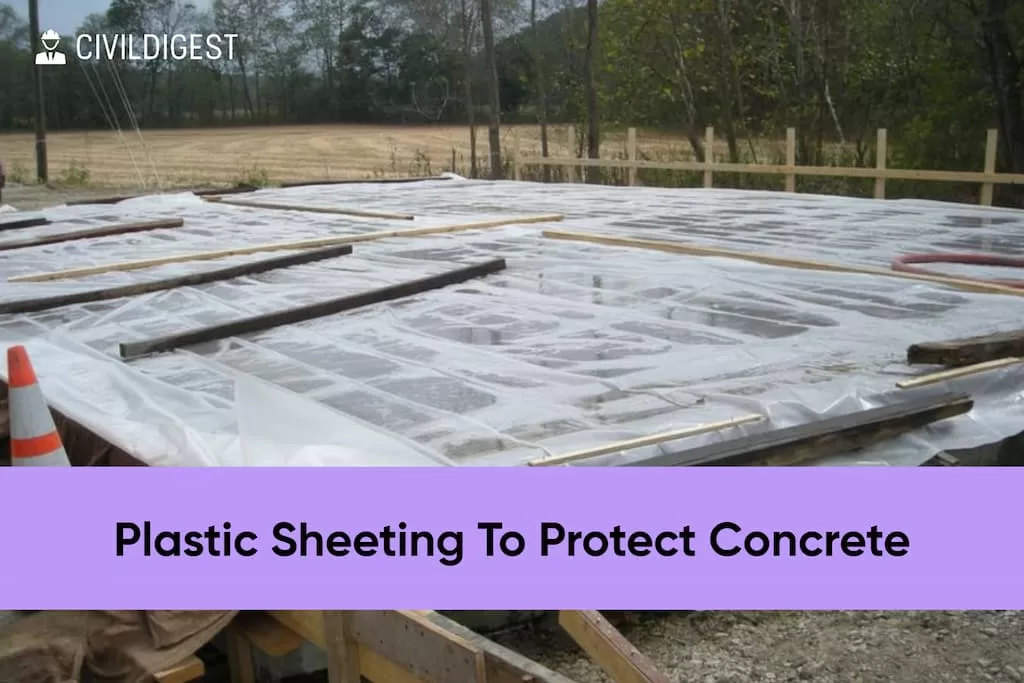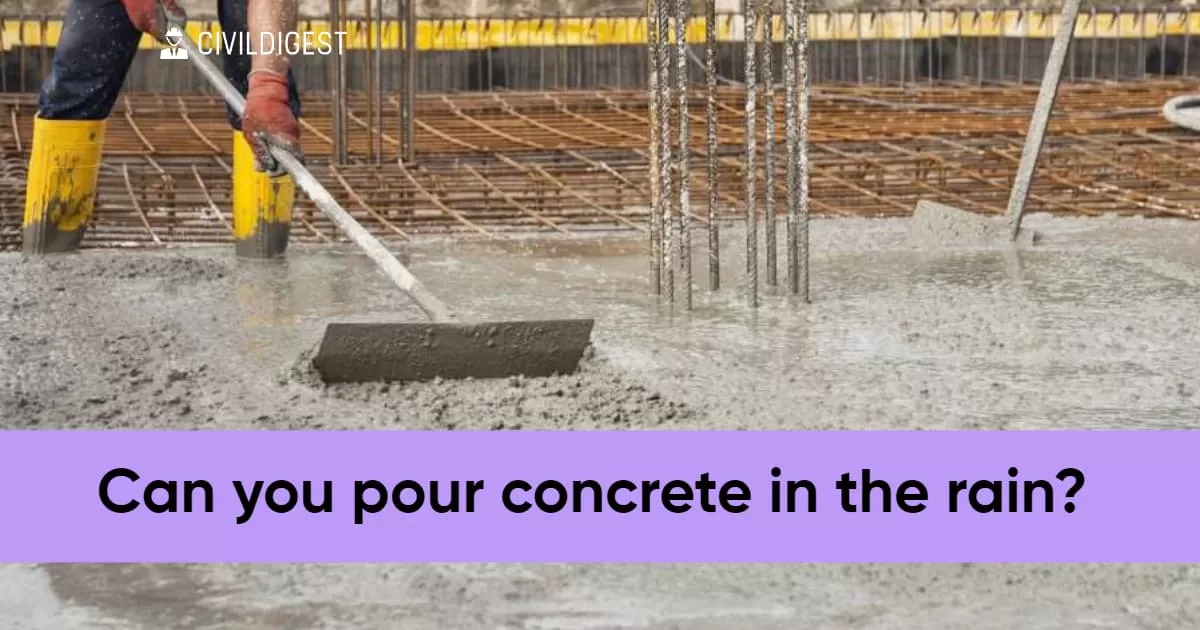YES, You can pour concrete in the rain, but, It’s not ideal. Sometimes waiting isn’t an option. If rain is coming, cover your site. Use plastic sheets or tarpaulin to keep it dry. In this guide, we’ll explore what happens when rain meets wet concrete, and how to manage it. Let’s dive in.
Table of Contents
What happens if you pour concrete in the rain?
Pouring concrete in the rain is not an ideal situation, and having been involved in such instances, I can pinpoint the issues that can arise.
- Dilution of the Concrete Mix
Freshly poured concrete can get diluted with rainwater, affecting the cement-water ratio adversely. The surface may become weak and may not achieve the desired strength.
This isn’t just a superficial problem. A diluted concrete surface can lead to long-term structural issues, as the weakened outer layer can crack over time, potentially leading to deeper structural issues.
- Formation of Puddles and Hollows
Rain can cause the formation of puddles and hollows on the concrete surface, disrupting the level surface. These deformities can become weak points in the structure, prone to cracking and damage over time. In the hands of an expert, minor imperfections can sometimes be corrected before the concrete sets fully, preventing long-term damage.

- Delay in the Curing Process
The rain can cause delays in the curing process, which may extend the project timeline.
Delays might translate to additional costs in labor and materials. Interestingly, a longer curing process can sometimes result in a stronger final product, although this is not a guarantee and depends heavily on the specific conditions.
- Aesthetic Compromises
Fresh concrete affected by rain can dry unevenly, resulting in a patchy appearance.
The surface finish might not be as smooth and could show signs of water damage.
While this affects the aesthetic quality, it doesn’t always indicate a structural problem. However, for projects where appearance matters, this could be a significant issue.
From my experience, when faced with the challenge of a sudden downpour, swift action to protect the surface, perhaps with tarpaulin or a similar covering, can mitigate some of the potential damages.
Is it bad if it rains the day after pouring concrete?
Yes, rain the day after pouring concrete is not favorable. Here’s why,
- Rain on freshly laid concrete can erode the surface, jeopardizing a smooth and level finish.
- Excessive water from the rain can disturb the meticulously calculated water-cement mix. This alteration can result in weak concrete and hinder the curing process.
- If a heavy rain forecast is predicted a day or two ahead of the concrete pour, it’s best practice to shield the ground using plastic sheeting. This prevents the subgrade, or base layer, from becoming overly saturated, which can later affect the concrete’s stability.
- In cases where rain surprises a project before the concrete slab can be covered, it’s essential to wait until the rain ceases. Afterward, one should promptly remove any pooled water from the concrete surface to ensure proper finishing.
- Prolonged and heavy rainfall can decelerate the concrete’s curing process. The internal bond between the particles in the mix becomes affected, leading to concrete that may not achieve its intended strength.

How long does concrete take to dry after rain?
Initial Drying:
- Concrete typically dries in about 24 to 48 hours after exposure to rain. This is the phase when it achieves its final setting time.
Full Curing:
- For concrete to reach about 90% of its strength through complete hydration and curing, you’re looking at a duration of 14 to 28 days.
Can you pour concrete in light rain?
Yes, you can pour concrete in light rain, but there are vital considerations to keep in mind:
Surface Preparation:
Before pouring, ensure the subgrade isn’t oversaturated. An overly wet base can cause the concrete to weaken over time.
Water-Cement Ratio:
Light rain can still alter the water-cement mixture. Even a slight imbalance can compromise the strength and durability of the concrete. Always monitor the mix.
Setting and Curing:
Light rain might not cause immediate visible damage, but it can slow down the setting time. Additionally, it can impact the curing process, which is critical for concrete strength.
Protective Measures:
Use covers or sheets to protect the area if you expect light rain during the pour. This can prevent excess water from mixing with the concrete.
How long does concrete take to dry before rain?
- Concrete surfaces are typically safe from light rain about 4 to 8 hours after pouring. This is when the surface is hard enough to resist imprinting.
- While the surface might seem dry, internal drying and strength development continue. As mentioned earlier, it takes approximately 24 to 48 hours for concrete to achieve its final setting time after exposure.
- Complete curing, leading to 90% strength, requires a 14 to 28-day window. It’s ideal to protect the concrete from heavy rainfall during this period to ensure optimal strength.
How do I know whether concrete has been damaged by rain?
- Surface Discoloration:
Uneven shades or pale patches on the surface often indicate water damage.
- Soft Spots:
If the concrete surface feels soft or spongy underfoot, it’s a clear sign that the rain has affected the curing process.
- Cracks:
Look out for unusual cracks or fissures. While some cracking is natural, rain can induce or aggravate such issues.
- Erosion Marks:
Rain can wash away the top layer of the concrete, leaving behind noticeable erosion marks.
How can I protect concrete when it rains?
Taking preventive measures is crucial to shield your concrete from the detrimental effects of rain:

- Weather Forecast:
Always check the weather prediction before a pour. If rain seems likely, consider rescheduling.
- Plastic Sheeting:
If rain catches you off guard, use thick plastic sheeting or tarps to cover the concrete surface. Ensure they’re anchored securely to avoid being blown away.
- Temporary Structures:
Erecting temporary tents or canopies over the pouring site can offer protection against unexpected drizzles.
- Water-Repelling Admixtures:
Consider adding water-repelling agents to your concrete mix. They make the concrete less permeable to water, offering an added layer of protection.
Solutions for rain-damaged concrete
Minor Damage:
Minor damages like cracks or chips are often manageable with DIY solutions:
- Begin by using a wire brush to clean the damaged area, ensuring the removal of any loose debris.
- Apply a concrete patch or epoxy to fill the cracks or chips.
- Let it dry entirely before putting the concrete to use.
Moderate Damage:
For moderate damages such as large cracks or a considerable chunk of missing concrete:
- Engage a professional. They will typically grind the damaged region back to intact concrete.
- The expert will then lay a new concrete layer or use a bonding agent on the surface.
Severe Damage:
When the damage is substantial, like extensive spalling or crumbling:
- Consider replacing the concrete. It’s an extensive project that necessitates a professional’s expertise.
- Grinding the concrete removes the texture on the surface and may expose the aggregate. If this appearance is acceptable, sealing it with an acrylic sealer, bonding agent, or densifier can prevent future damage.
Diamond Grinding:
One of the primary methods to address rain damage is diamond grinding, especially in areas where the surface paste is diluted.
Conclusion
Pouring concrete during rain isn’t the preferred method but, with caution and knowledge, it’s manageable. From understanding the immediate effects of rain on wet concrete to considering the implications of light rain, it’s essential to be informed.
By taking protective measures, addressing rain-damaged concrete, and adhering to best practices, you can navigate the challenges rain presents.
Remember, preparation and understanding are keys to successful construction projects, rain or shine. If ever in doubt, always prioritize safety and consult with experts in the field of construction and concrete pouring.
FAQ about pour concrete in the rain
can you lay concrete blocks in the rain
You can lay concrete blocks in light rain, but they should be protected with a polythene sheet.
Can You Pour Concrete on Wet Ground?
Concrete should not be poured on very wet surfaces as it compromises the quality.












